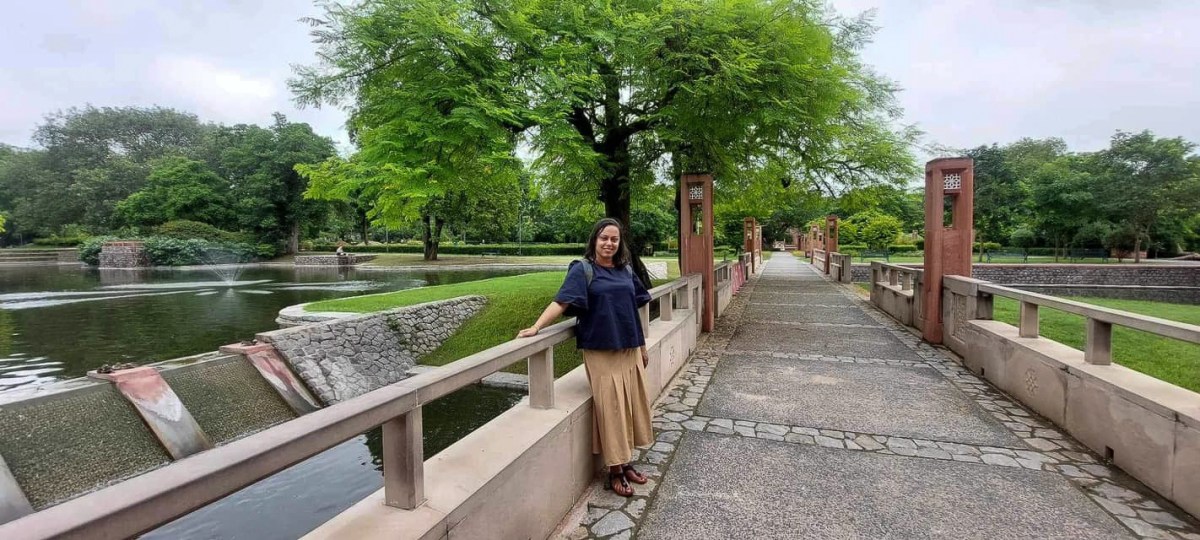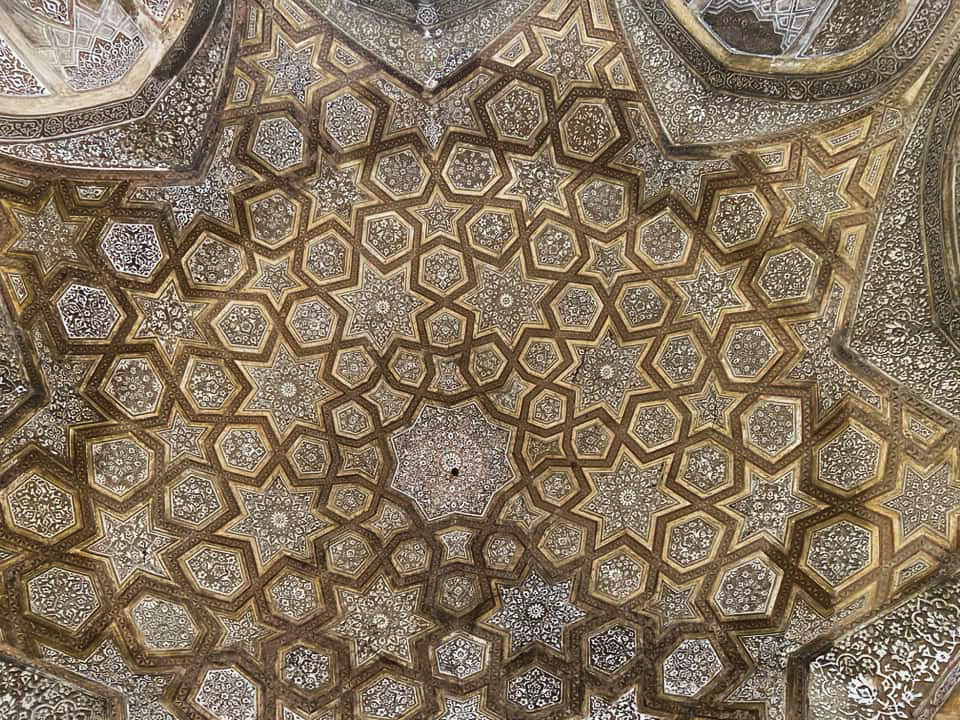When I lived in Delhi, Sunder Nursery was in ruins. It was restored and brought back to glory recently and the whole of Delhi seemed to have gone crazy about it. I was interested in it not only because of the picturesque it evoked but also because of its ´´ruins-to-glory´´ story. I like beautiful things and the joy they bring. I find it a pity for a thing of beauty to be destroyed and love it when love, patience, and efforts bring it back to its original glory (or near original). The successful restoration of Sunder Nursery reminded me of Al Azhar Park in Cairo and I wondered if it was as charming a place. I always wanted to visit this site but somehow, I did not manage to do so because of my travel plans.

You can almost feel the tranquility in this photo
Table of Contents
Sunder Nursery in Monsoon
It was in the middle of this year that I visited Sunder Nursery. The Indian subcontinent was going through the annual monsoon and even Delhi, an otherwise dry place, received a regular deluge of rain. The skies were gray and the air was so thick and muggy that I could have almost cut it with a knife. There were occasional spots of sunshine but mostly rainy, moody weather with dramatic skies prevailed. The heavy moisture made Delhi´s abundance of trees burst out in flowers and to me, it seemed like a perfect time to visit the famous Sunder Nursery.

The beautiful interiors of the complex
A place for long walks and tranquility
I went there with a friend and thankfully, found it devoid of crowds. Although, I did not know what to expect, the beautiful, green complex did not disappoint me. It had a mix of water bodies, tiered water channels, a couple of historical monuments, and lots of tree cover. Different kinds of trees of different kinds grew in abundance there and flowers everywhere. Gnarly old roots of wise, old Methuselah-like trees took over ruins and I liked the fact that they were left undisturbed. Although a bit too manicured, I liked that at places, the landscape designer had wisely let nature be. It was lovely. The abundance of trees led to plenty of birds calling the Sunder Nursery home and bright-eyed striped squirrels with bushy tails scampered around fearlessly. Salamanders, lizards, and geckos reposed in shady spots, and Sunder Nursery seemed to me to be the perfect spot for sharing confidences, and canoodling. My friend and I spent a wonderful day walking around this lovely site and this is one site that, in my opinion, has not been ruined by zealous human intervention. Take a look at this photo essay and decide for yourself.
Sunder Nursery Travel Guide
What is Sunder Nursery?
Delhi´s newest green hotspot, the Sunder Nursery is situated opposite the magnificent Humayun´s Tomb complex on the historic Grand Trunk Road. I often wondered if proximity to such an overpowering Mughal site was not a reason why Sunder Nursery and the adjoining Batashewala Complex were overlooked for such a long time. However, restoration has finally happened, and Sunder Nursery has risen from ruins thanks to the incredible efforts of the Aga Khan Trust for Culture (AKTC) in collaboration with the CPWD and SDMC. More than a decade of painstaking work has turned this site into a beautiful 9ß-acre biodiversity park. It is now resplendent with 15 historic monuments, 300 species of trees, 8ß species of birds, 40 species of butterflies, 2 amphitheaters, a bonsai enclosure, a peafowl zone, and numerous water bodies. Out of the fifteen heritage monuments that the Sunder Nursery contains, 6 are UNESCO World Heritage Sites, including Archaeological Survey of India (ASI) protected Sundarwala Burj, Sundarwala Mahal and Lakkarwala Burj.
A brief history
Sunder Nursery was built by the Mughals in the 16th century. It was called Azim Bagh then. However, Delhi´s political fate changed hands and so did the site´s name and glory. Its condition deteriorated and Sunder Nursery was in a sorry state until the British took charge of it. That was in 1911 when the British shifted their capital from Calcutta to Delhi and Alick Percy Lancaster, the last British horticulturist in India, took charge of the site. He revived the Sunder Nursery by experimenting there with the imported trees that would later be planted along New Delhi’s avenues. Thus it was named ‘Nursery’. The “Sunder” is derived from the ‘Sunder Burj’ tomb located within the complex. Bad luck, however, would soon follow, and due to the hasty separation of India and Pakistan, Sunder Nursery became a refugee camp for part of the millions of Hindus who came from the other side of the border in 1947. Its condition again declined and the tombs and trees were once again forgotten till 2008. That was when the Sunder Nursery once again got a lease of life and the Aga Khan Trust for Culture and Delhi’s Central Public Works Department decided to restore it as a part of the Nizamuddin Urban Renewal Initiative. The restoration project lasted 10 years and the Sunder Nursery was re-opened to the public in February 2018. Today, it is one of the most beautifully transformed places in the world and the most charming public park in Delhi.
Location and how to reach
It is right next to the Humayun’s Tomb, in Nizamuddin West, in New Delhi. The nearest metro stations are the JLN Stadium on the Violet Line and the Supreme Court Station on the Blue Line. Once you get out of the stations, there are plenty of autorickshaws that will bring you to the Sunder Nursery. Bargain a bit. Alternatively, you can also go there by Uber which is super cheap and reliable in Delhi. There are bus stops just outside Humayun’s Tomb and you can walk to the Sunder Nursery from there. Car parking is available at the site.
Opening Hours and best time to visit
The Sunder Nursery is open daily (April – September: 7 am to 7 pm and October – March: 7 am to 6 pm). Go there in the mornings or afternoons. Avoid weekends and public holidays if you don´t like crowds.
Sunder Nursery Entry Fees
- For Indian/ SAARC visitors – Rs. 35
- For Foreign Tourists – Rs. 100
- For Children between the ages of 5-12 years – Rs.15
- For Senior Citizens, above the age of 60 years – Rs.15
- Children under 5 years – Free Entry
- Physically Challenged Visitors – Free Entry (Wheelchair is available at the entrance)

Attractions inside the Sunder Nursery
- Sunder Burj – Nearly 100 meters away from the main entrance, this is probably the first monument one sees. It is a 16th-century tomb notable for its highly decorative star-patterned internal ceiling and intricate inscriptions on its walls. Restoration of this monument that had suffered heavy damage from water seepage started in October 2010. To date, nobody knows who is interred here. In the area on the north of Sunder Burj lies the 500-meter-long water canal adorned with ten handcrafted lotus-shaped marble fountains, gorgeous star-shaped flowerbeds, and sandstone benches.
- Lakkarwala Burj – Continue further northwest and you will find a larger mausoleum for some unknown noble person. It is called the Lakkarwala Burj. This 16th-century red sandstone monument which is intricately decorated with Quranic inscriptions, is surrounded by a rose garden containing 30 varieties of roses from around the world.
- Apart from these monuments, there are the Azim Bagh and Azimganj Serais, Sunderwala Mahal, Mirza Muzaffar Hussain’s Tomb, and Batashewala Mahal. The last one is dilapidated and very few visitors venture on this side of the park. However, it´s very tranquil and is an excellent place for birding.

Miscellaneous Information
- Public toilets are available inside the complex.
- Carry packed lunch and water. A beautiful outdoor cafe called Fab Cafe is located inside the complex. There are a few food kiosks also.
- There is a children´s playground.
- Wear a hat and sunglasses.
- Every Sunday, an organic and lifestyle market is held on the grounds.
- Smoking and drinking alcohol are prohibited inside the complex.
- If you are interested in the details of the different historical monuments inside the Sunder Nursery, then check out this post by Kevinstandagephotography.
- You can bring your pets here. However, you’ve to keep them on a leash and pick up the litter.
- To know more about the restoration project, check out the official website of Sunder Nursery.

The map of Sunder Nursery photo credit – Kevinstandagephotography

Sunder Burj

The starry ceiling of the Sunder Burj

The beautiful ceiling inside Lakkarwala Burj


Mausoleum of Mirza Muzaffar Hussain inside the Batashewala complex

The interior of this mausoleum


Follow the rest of the Delhi series
- INDIA TRIP IN A NUTSHELL
- STREET ART IN DELHI
- DELHI GARDENS AND PARKS
- KHAORI BAOLI SPICE MARKET IN DELHI
- DELHI IN WINTER
- JAMA MASJID IN DELHI
- KATHPUTLI COLONY IN DELHI
- OUR WONDERFUL DELHI CITY STAY
- LODHI GARDENS, MY FAVOURITE DELHI PARK
- AN AFTERNOON AT SAFDARJUNG TOMB
RESPONSIBLE TRAVELING-BECAUSE I CARE

